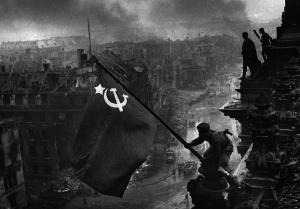The Western image of World War II, particularly the American one, is one of a conflict that we won, whether at Normandy or Iwo Jima, through the help of such men as George S. Patton, Dwight D. Eisenhower and Winston Churchill, or thanks to such weapons as the atomic bomb. In Russia, however, World War II, or as they call it, “The Great Patriotic War”, is portrayed in a vastly different light. This past Saturday marked the 70th annual “Victory Day” in Russia. It marked one of Moscow’s largest military parades ever, with more than 16,000 troops, 140 aircraft and 190 armored vehicles, including the debut of Russia’s brand new next-generation tank. Unfortunately, few of the world’s major leaders were in attendance, and much of western media didn’t pay much attention to it, except to laugh when something didn’t go right.
Unfortunately, current tensions between Russia and much of the West have obscured the scale of what the Soviets are commemorating with Victory Day; starting in 1941, the Soviet Union bore the brunt of the Nazi offensive, and played a major role in the defeat of Hitler. By one calculation, for every single American soldier killed fighting the Germans, the Soviets lost 80. In the same vein, roughly three quarters of Germany’s casualties in World War II occurred on its eastern front. While the Russians emerged victorious, it was at an extremely high cost of life; an estimated 26 million Soviet citizens died during World War II, 11 million of those being soldiers.
The epic, brutal battles that rolled back the Nazi advance in the Soviet Union, such as the brutal winter siege of Stalingrad and the clash of thousands of armored vehicles at Kursk, had no parallel on the Western Front. Unlike the US, where the war was fought on distant shores, for the Soviet Union, it was fought in their own backyard, against a foe who viewed the Communist Russians as an ethnically, ideologically and politically inferior people, who deserved to be reduced to servitude and ultimate extermination. Hitler viewed Eastern Europe as “lebensraum”, land that needed to be cleared of “inferior” Slavic peoples so that it could be settled by the German race. Therefore, the Soviet Union’s success at pushing back the German onslaught not only meant their victory against the Nazis, but its peoples’ very survival.
By 1943, the Soviet Union had already lost some 5 million soldiers, as well as two-thirds of its industrial capacity, to the Nazis. Yet they were still able to turn back the German invasion and march onto Berlin, a testament to the courage and tenacity of the Soviet war effort. Even before the start of World War II, the Soviet Union under Stalin had the blood of millions on its hands. In the 8 years leading up to World War II, some four million people were shot or starved to death in Ukraine, Belarus and the Leningrad district through the Stalinist purges. However, the Germans managed to starve and shoot even more Russians in half the time. Between 1933 and 1945 in the “bloodlands”, that territory on the Geman-Soviet border, some 14 million civilians were killed. By some accounts, 60 percent of Soviet households lost a member of their nuclear family. Unfortunately, many of the countries that were conquered by the Nazis were subsequently occupied by the Soviets, often with matching brutality, and many have found it hard to separate the Soviet victory from the decades of Cold War domination in that triumph’s aftermath.
